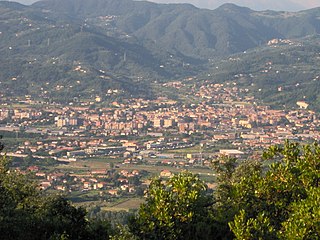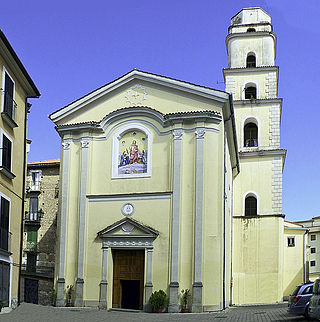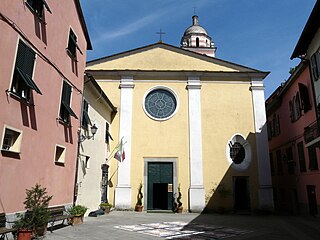
The Archdiocese of Genoa is a Latin Church ecclesiastical territory or diocese of the Catholic Church in Italy. Erected in the 3rd century, it was elevated to an archdiocese on 20 March 1133. The archdiocese of Genoa was, in 1986, united with the Diocese of Bobbio-San Colombano, forming the Archdiocese of Genoa-Bobbio; however a split in 1989 renamed it the "Archdiocese of Genoa."

Sarzana is a town, comune (municipality) and former short-lived Catholic bishopric in the Province of La Spezia, Liguria, Italy. It is 15 kilometres (9 mi) east of La Spezia, on the railway to Pisa, at the point where the railway to Parma diverges to the north. In 2010, it had a population of 21,978.

The Archdiocese of Turin is a Latin Church ecclesiastical territory of the Catholic Church in Italy.

The Diocese of Vallo della Lucania is a Latin Church diocese of the Catholic Church in Campania, has existed under this name since 1945. It is a suffragan of the Archdiocese of Salerno-Campagna-Acerno.

The Diocese of Savona-Noli is a Latin diocese of the Catholic Church in northern Italy. It was historically the Diocese of Savona, from the tenth century. In 1820 the Diocese of Noli was united to the Diocese of Savona. It is a suffragan of the Archdiocese of Genoa.

The Diocese of Tivoli is a Latin Church ecclesiastical territory or diocese of the Catholic Church in Latium, Italy, which has existed since the 2nd century. In 2002 territory was added to it from the Territorial Abbey of Subiaco. The diocese is immediately exempt to the Holy See.

The Diocese of Ventimiglia-Sanremo is a Latin diocese of the Catholic Church in Liguria, northern Italy. The name of the historic Diocese of Ventimiglia was changed in 1975. It was originally a suffragan diocese of the Metropolitanate of Milan up to 1806, when it was transferred to the Metropolitanate of Aix; but it has been a suffragan of the Archdiocese of Genoa since 1818.

The Diocese of Albenga–Imperia is a Latin diocese of the Catholic Church in Liguria, northern Italy; the traditional name of the Diocese of Albenga was changed by decree of the Congregation of Bishops in the Roman Curia, with the approval of Pope Paul VI, on 1 December 1973. It is a suffragan of the Archdiocese of Genoa.

The Diocese of La Spezia-Sarzana-Brugnato is a Latin diocese of the Catholic Church in Liguria, northern Italy, created in 1929. It is a suffragan of the Archdiocese of Genoa.

Brugnato Cathedral is a Roman Catholic cathedral located in the old centre of the city of Brugnato, in the Val di Vara in the province of La Spezia, Italy. The dedication is to Saint Peter, Saint Laurence and Saint Columbanus. Once the seat of the bishops of Brugnato, it is now a co-cathedral in the Diocese of La Spezia-Sarzana-Brugnato.
The Roman Catholic Diocese of Brugnato was a Roman Catholic diocese located in the city of Brugnato in the Province of La Spezia in the Italian region Liguria of Italy. On 25 November 1820, it was united with and suppressed to the Diocese of Luni e Sarzana to form the Diocese of Luni, Sarzana e Brugnato.
The Roman Catholic Diocese of Pesto was a bishopric, later under the name of Capaccio, and became a Latin Catholic titular see in 1966.

The Diocese of Nebbio was a Roman Catholic diocese located in the town of Saint-Florent in Corsica. The Cathedral is on a low hill one mile from the port of Saint-Florent. In the Medieval period the Bishop of Nebbio was also the temporal lord of nearly all the lands in his diocese. In 1667, Nebbio was completely abandoned and the bishop lived in Saint-Florent, a town of about 200 inhabitants, under the dominion of the Republic of Genoa. The diocese had some 22 places. The Cathedral Chapter had two dignities, the Archdeacon and the Provost, and three Canons. In 1770 the diocese was under the dominion of the King of France, and Saint-Fleur had about 600 inhabitants. The Chapter of the Cathedral still existed, with two dignities and six Canons.
Giovanni Battista Bracelli was a Roman Catholic prelate who served as Bishop of Luni e Sarzana (1572–1590).

The Diocese of Noli was a Roman Catholic diocese located in the town of Noli of Liguria, Italy, in the Province of Savona. It was established in 1237, on territory which had been taken from the diocese of Savona. In 1820, it was united with the Diocese of Savona to form the Diocese of Savona e Noli.
Ventura Benassai was a Roman Catholic prelate who served as Bishop of Massa Marittima (1501–1511).
Tommaso della Testa Piccolomini was a Roman Catholic prelate who served as Bishop of Sovana and Bishop of Pienza and Montalcino (1470–1482).
Giovanni Battista Spínola (1625–1705) was a Roman Catholic prelate who served as Archbishop of Genoa (1694–1705) and Bishop of Luni e Sarzana (1665–1694).
Giovanni Girolamo Naselli (1640–1709) was a Roman Catholic prelate who served as Bishop of Luni e Sarzana (1695–1709) and Bishop of Ventimiglia (1685–1695).
Guala da Telgate was a bishop of the Roman Catholic diocese of Bergamo.











